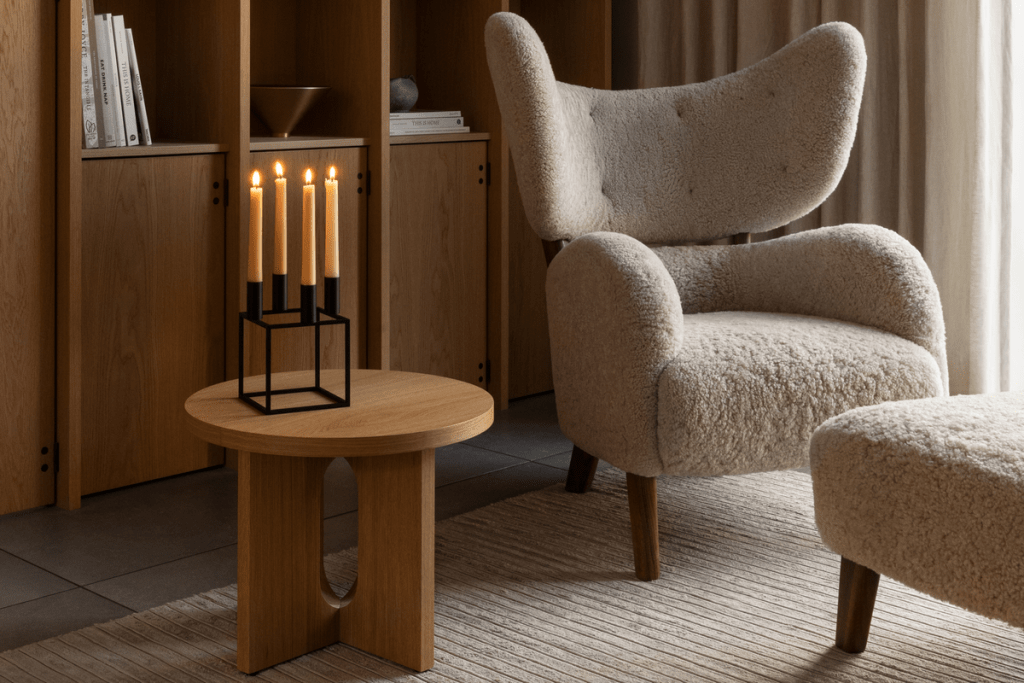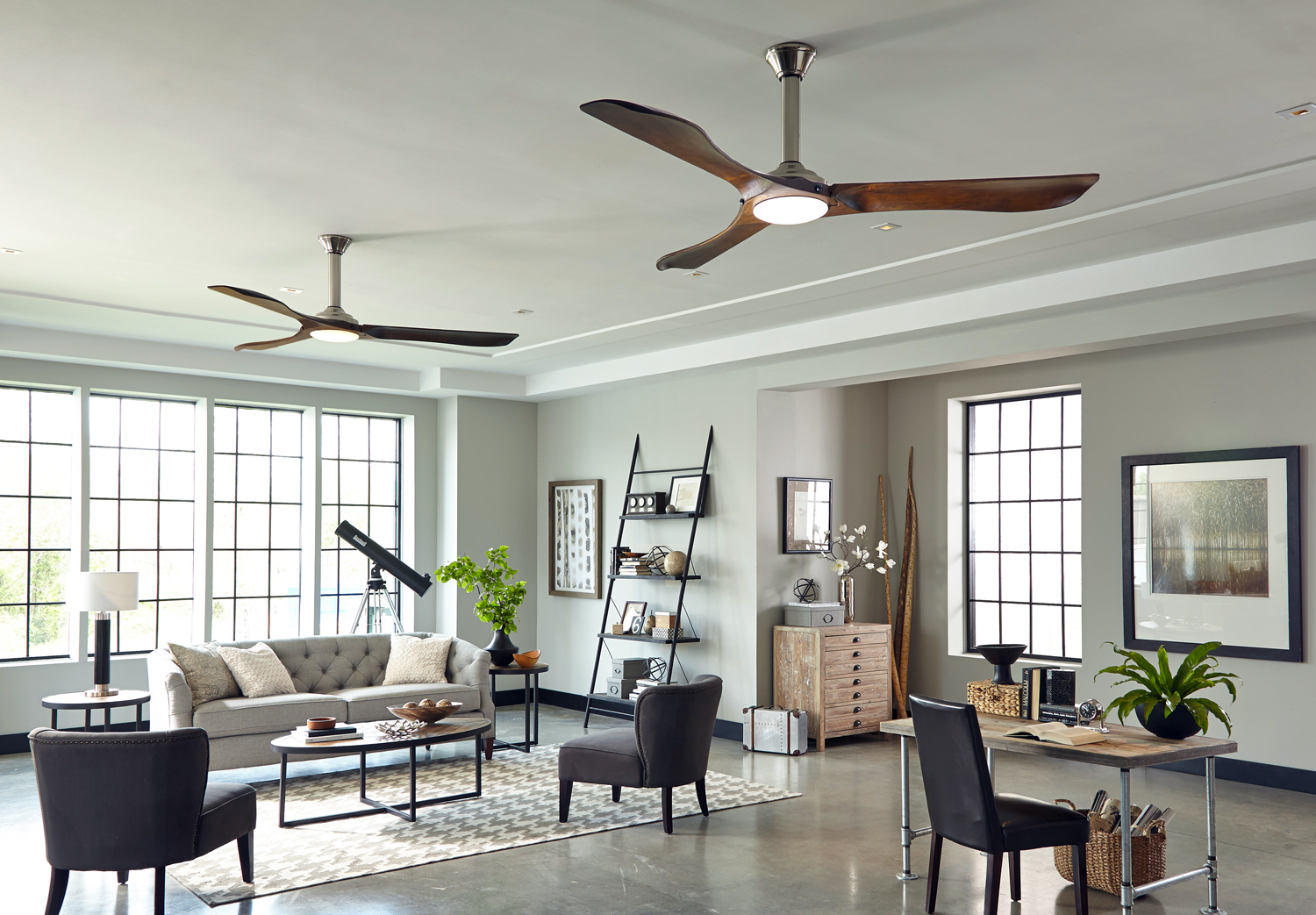
Ceiling fans come in a nearly endless array of sizes, blade counts and finishes, so choosing the right ceiling fan comes down to proportions, cooling efficiency and design elements. We’ve compiled some expert advice to simplify the process of choosing a ceiling fan.
This guide covers the many considerations of shopping for modern ceiling fans like ceiling height and mounting options for sloped ceilings, how to measure for a ceiling fan and the optimal size of fan needed for every room, airflow and CFM requirements, the difference in length and number of blades, ceiling fan finishes and materials, and more.
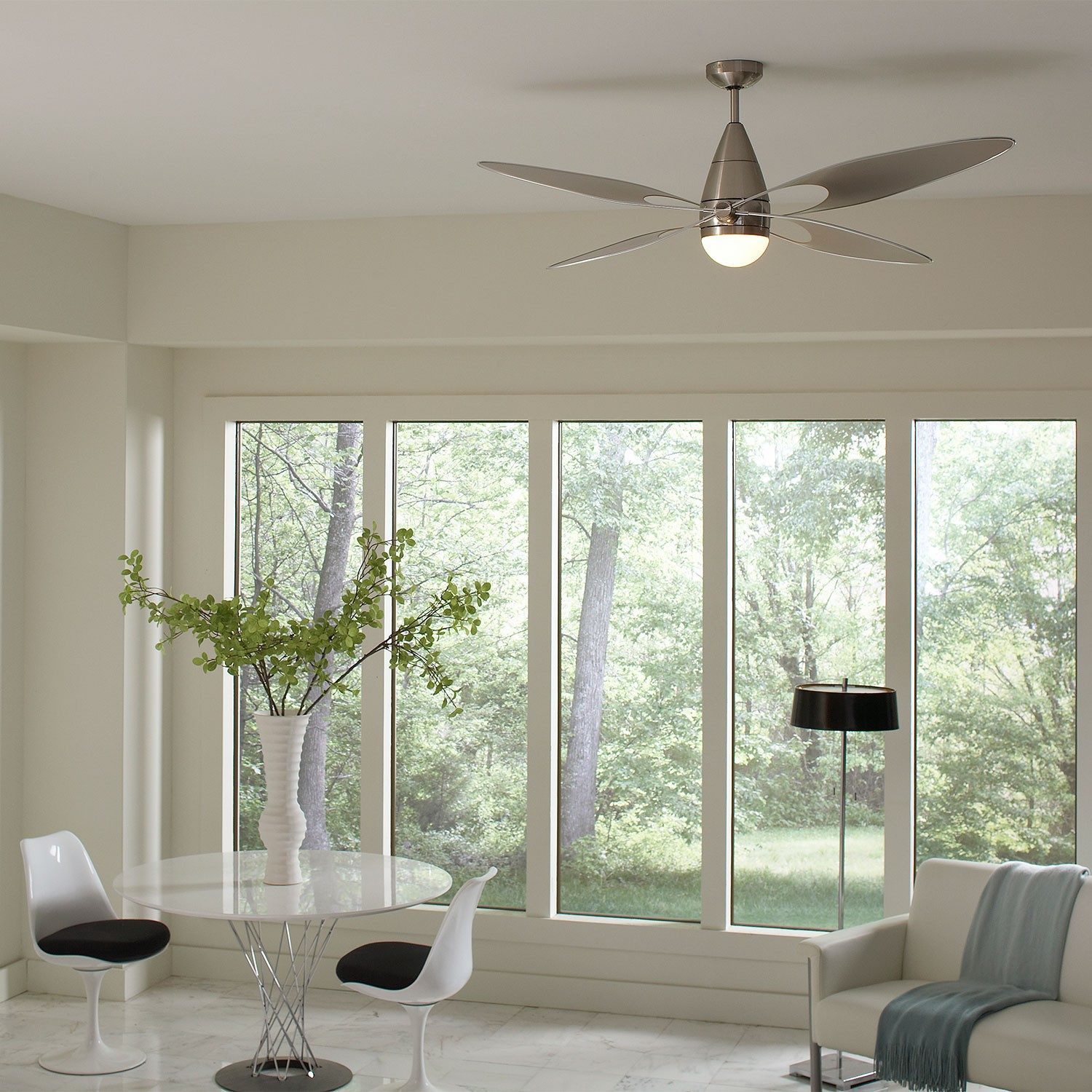
What Size Ceiling Fan Do I Need?
The first thing to consider when deciding on a ceiling fan size is the size of the room in which it will be installed. The square footage of the room dictates how big the ceiling fan needs to be because a fan that is too small or big for a space will not circulate air properly.
Ceiling fans are measured by the full size of their blade span (also called blade sweep), which is the diameter of the circle seen when the fan blades are in motion. Fan blade span reaches from the tip of one fan blade to the tip of the blade directly across.
With the dimensions of the room in hand, the size guide below estimates the optimally sized ceiling fan for each space:
Ceiling Fan Size Guide:
| Fan Size | Room Size | Room Type |
| 29″ or less | less than 50 sq. ft. | Hallway, Laundry Room, Walk-In Closet |
| 36″ | up to 75 sq. ft. | Breakfast Nook, Large Bathroom |
| 42″ | up to 100 sq. ft. | Bedroom, Office, Kitchen |
| 52″ | up to 225 sq. ft. | Master Bedroom, Dining Room, Patio Area |
| 56″ | up to 400 sq. ft. | Large Living Room, Great Room |
In larger spaces, depending on the shape of the room, another option is to install two smaller fans.
When determining the correct size of a ceiling fan for its space, a minimum of 18 inches to 24 inches of clearance on all sides of the fan is recommended.
How low should my ceiling fan hang?
To meet building codes, the bottom of the fan should be at least 7 feet off the floor; 8 to 9 feet allows for optimal circulation. For higher ceilings, use fans with downrods to achieve the right height. The more space between the ceiling and the blades, the better for airflow and circulation. Ideally, aim for at least 12 inches.
- Low Ceilings: For rooms with ceilings 8 feet or shorter, flushmount “hugger” fans are the ideal option. As the name suggests, these fans “hug” the ceiling to create a low profile. In order to achieve their short height, these flush mount fans do not incorporate downrods in their design.
- Average and High Ceilings: To hang a fan at the appropriate height in a room with a ceiling 9 feet high or higher, a ceiling fan that uses a downrod is the right fit. A downrod ranges from 3 to 72 inches in length and is what suspends the fan from the canopy. This is ideal because more space between the fan blades and the ceiling results in better air circulation.
Fans typically come with one or two downrods, in different standard lengths. However, if more length is needed to achieve the ideal hanging height, additional downrods in other sizes can be purchased. For a room with a 9-foot ceiling, select a fan with a 6-inch downrod. For ceilings that are higher than 9 feet, add 6 inches to the downrod for every foot of height: 10-foot ceiling, 12-inch downrod; 11-foot ceiling, 18-inch downrod; and so on.
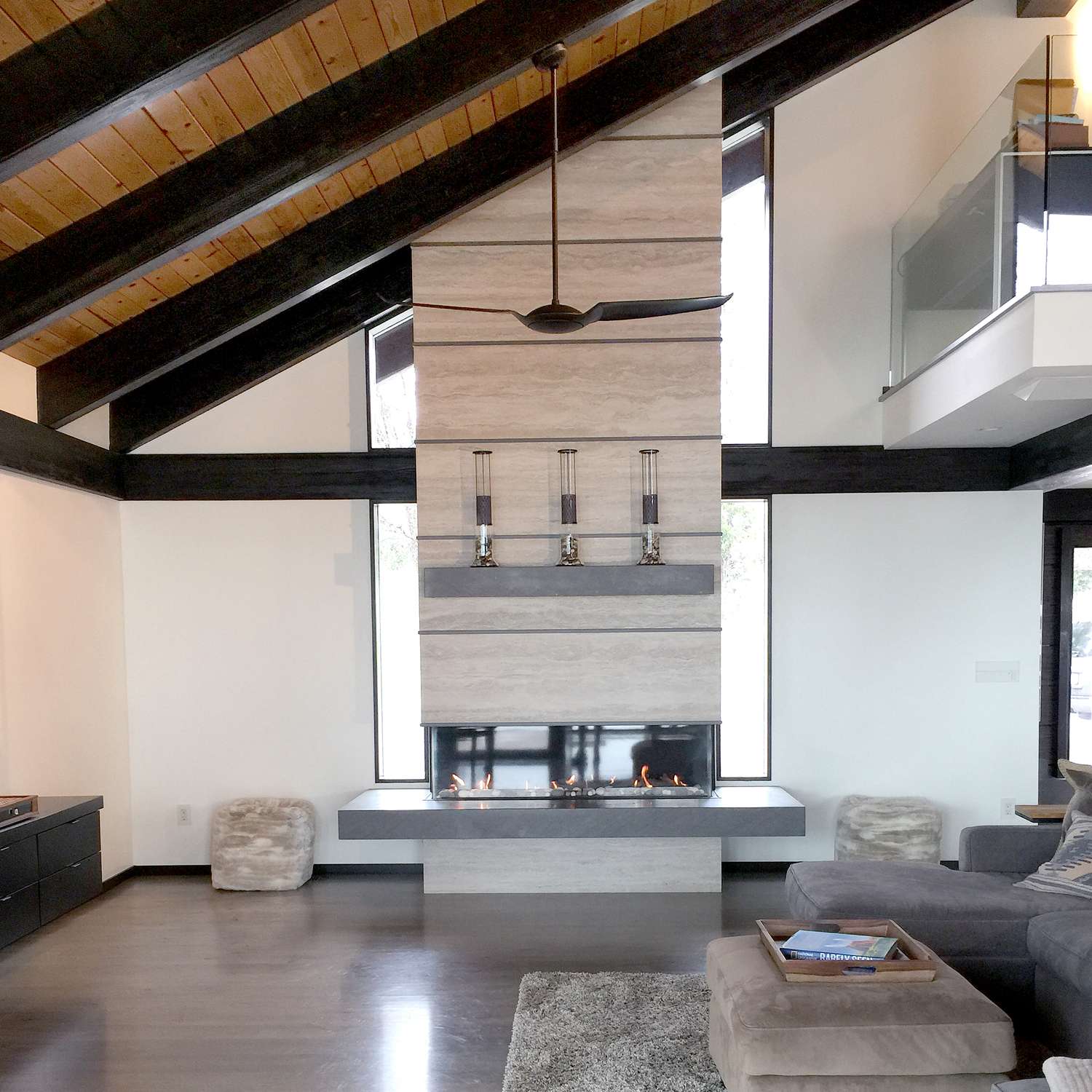
Can I install a ceiling fan if I have a sloped ceiling?
Aside from hugger fans, most fan canopies (the part that attaches to the ceiling and covers the junction box) can accommodate some degree of slope—usually up to 30 degrees. An additional longer downrod may be needed to ensure enough blade clearance. For steeper slopes—or in cases where sloped ceiling installation is explicitly not allowed—some manufacturers offer sloped-ceiling adapters, sometimes called angle mounts.
Do I need a special ceiling or junction box to mount my fan?
Yes. Ceiling fans must be mounted to junction boxes marked “For Use With Ceiling Fans;” because fans can weigh up to 50 pounds and are in motion, these specific J-boxes provide proper support. The boxes should be anchored to a ceiling joist, and installation by a licensed electrician is advised.
Should I buy a ceiling fan with a light kit?
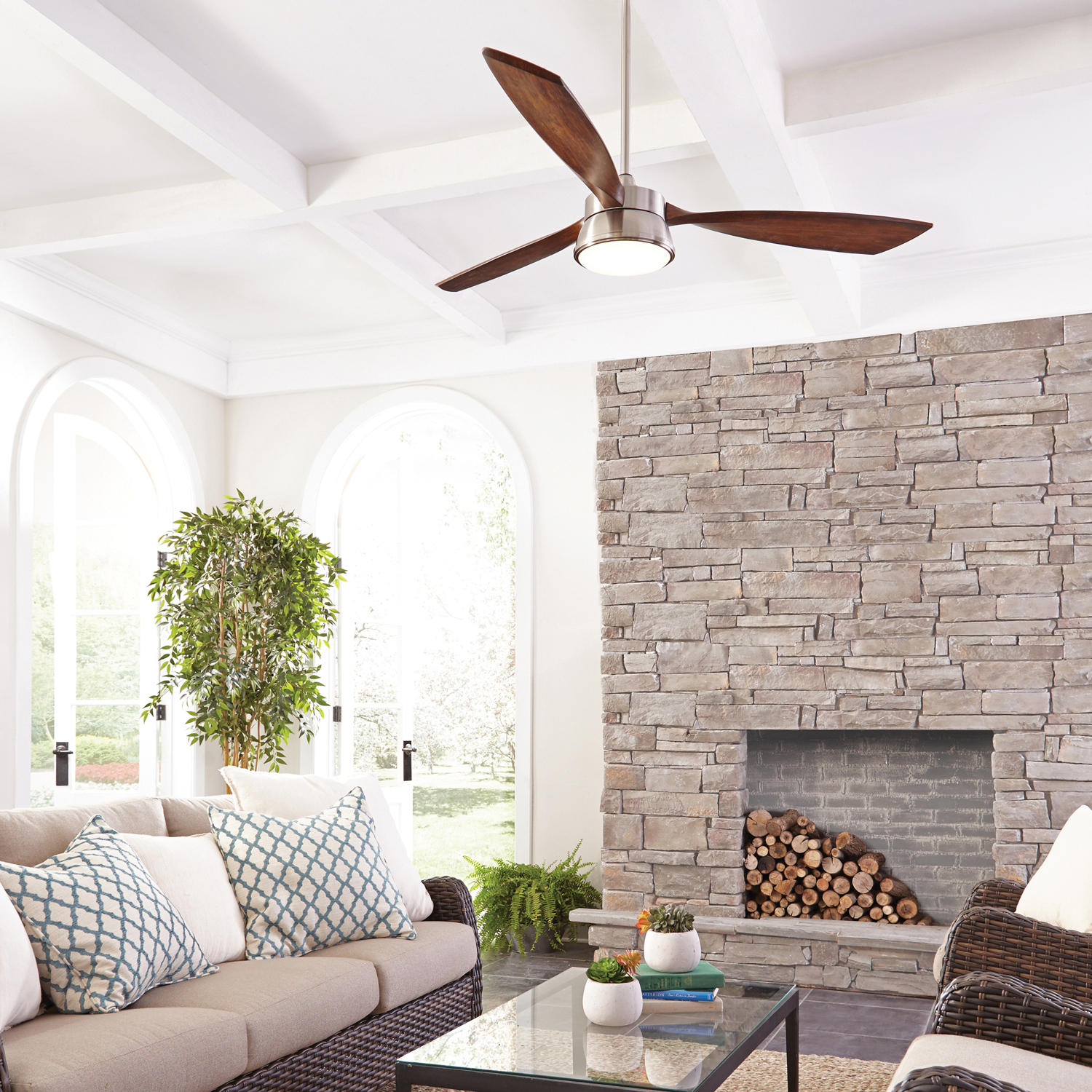
Start by determining how much light is already available in the room: Factors to consider are whether it’s a relatively open space with lots of windows or sliding glass doors that let in natural sunlight, how many lamps are already in place and whether they provide adequate lighting. These considerations will dictate whether the fan should have a light kit.
For the ultimate control over the amount of light in a room, a ceiling fan with a light or a light kit may be the best option. Ceiling fan light kits provide ample, even light that can be beneficial to all types of spaces. And many light kits are compatible with a wall dimmer or remote, so adjusting the light intensity is as easy as pressing a button.
Consider pairing ENERGY STAR fans with ENERGY STAR light kits, too. They’re proven to be 50% more efficient than conventional fan/light units, saving more than $170 in energy costs over the fan’s lifetime.
Can I use a ceiling fan outdoors?
Yes, as long as the outdoor ceiling fan is certified to be damp- or wet-location approved. Damp-rated ceiling fans can handle the moisture that comes with outdoor air but shouldn’t have direct contact with water, rain, snow or other liquids that a life outdoors could bring. Damp-rated fans also use materials that prevent rust and corrosion from outdoor elements. Wet-location-listed fans can be used in locations more susceptible to water contact. These feature water- and weather-resistant motor housings and blades, and some are equipped with waterproof light kits to provide additional lighting outdoors.
Should I choose an ENERGY STAR-Qualified ceiling fan?
Rising utility costs and an ever-increasing challenge to eliminate waste means we must get technologically creative. Investing in a ceiling fan with an ENERGY STAR label is a practical option that helps minimize waste while maximizing financial benefit.
The EPA came up with the ENERGY STAR label for two reasons: (1) to recognize units that have passed a rigorous testing process to prove they’re highly efficient, and (2) to make it easier for consumers to identify and purchase energy-efficient, bill-saving products that won’t sacrifice performance or comfort.
Plus, ENERGY STAR ceiling fan models must come with a minimum 30-year motor warranty, a one-year component(s) warranty and a two-year lighting kit warranty. When shopping fans at Lumens, look for the ENERGY STAR icon on a fan’s product page to determine if it is ENERGY STAR-qualified.
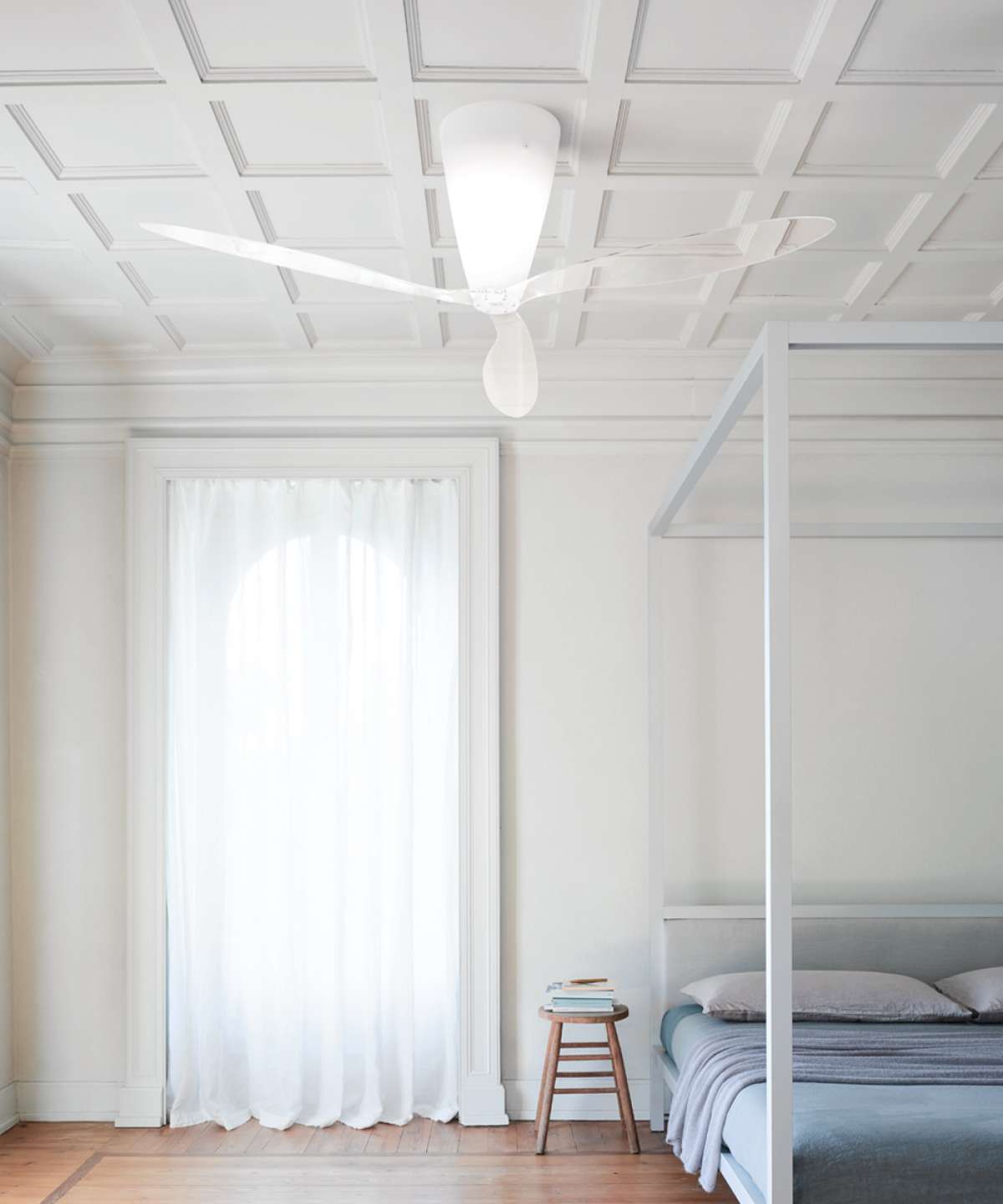
How does a ceiling fan work?
In its most basic sense, a ceiling fan works by rotating pitched blades. The pitched blades create airflow that produces better air circulation, offering a perception of cooling due to the movement of the fan pushing air to evaporate moisture off the skin. While a fan may enhance the effectiveness of an air-conditioning or heating system by circulating that cooled or heated air, a ceiling fan on its own does not affect the temperature of a space.
What is blade pitch?
The angle of the blade makes a difference in how much air a fan can circulate throughout a room. The optimal blade pitch for a ceiling fan is 12 to 15 degrees.
This degree of blade pitch allows the ceiling fan to move a “just right” amount of air; a steeper pitch creates a wind tunnel while a flatter blade won’t offer much breeze.
How do I control the fan?
There are three typical ways to operate a fan: a pull chain, a wall control or a handheld remote.
- Pull Chain: The pull chain is located on the fan and provides an easy way to adjust the speed and turn a fan on and off (and its light, if it has one).
- Wall Switch: Wall controls are as convenient a way to operate ceiling fans as a light switch is for a lamp. When installed next to a doorway, the chance of forgetting to turn off the fan when leaving a room is greatly reduced.
- Remote: The most convenient of all fan controls, handheld remotes allow for the fan to be operated from anywhere in the room, and many come with wall mounts to keep the remote as handy at the entrance as a wall switch.
In some instances, a fan can be installed with both a remote control and wall switch for the most flexibility.
Some smart ceiling fans and add-on accessories are equipped with technology to work with Google Home, Amazon Alexa and mobile devices, allowing you to be free of remotes and other controls.
Unfortunately, adding a remote to an already-installed fan is not usually as simple as putting batteries in the remote control. The receivers for handheld remotes and some wall-mounted controls often must be installed inside the fan. This may involve dismantling part of the fan to add the receiver and getting it put back together properly, which may require the help of a professional. Most receivers sit inside the ceiling fan’s canopy and can be wired into the existing electrical. From there, the remote is synced to its receiver.
Our selection of ceiling fan parts includes separate remotes, wall controls and light kits compatible with some fans sold at Lumens. The product details on each fan page will indicate when the fan includes a remote control.
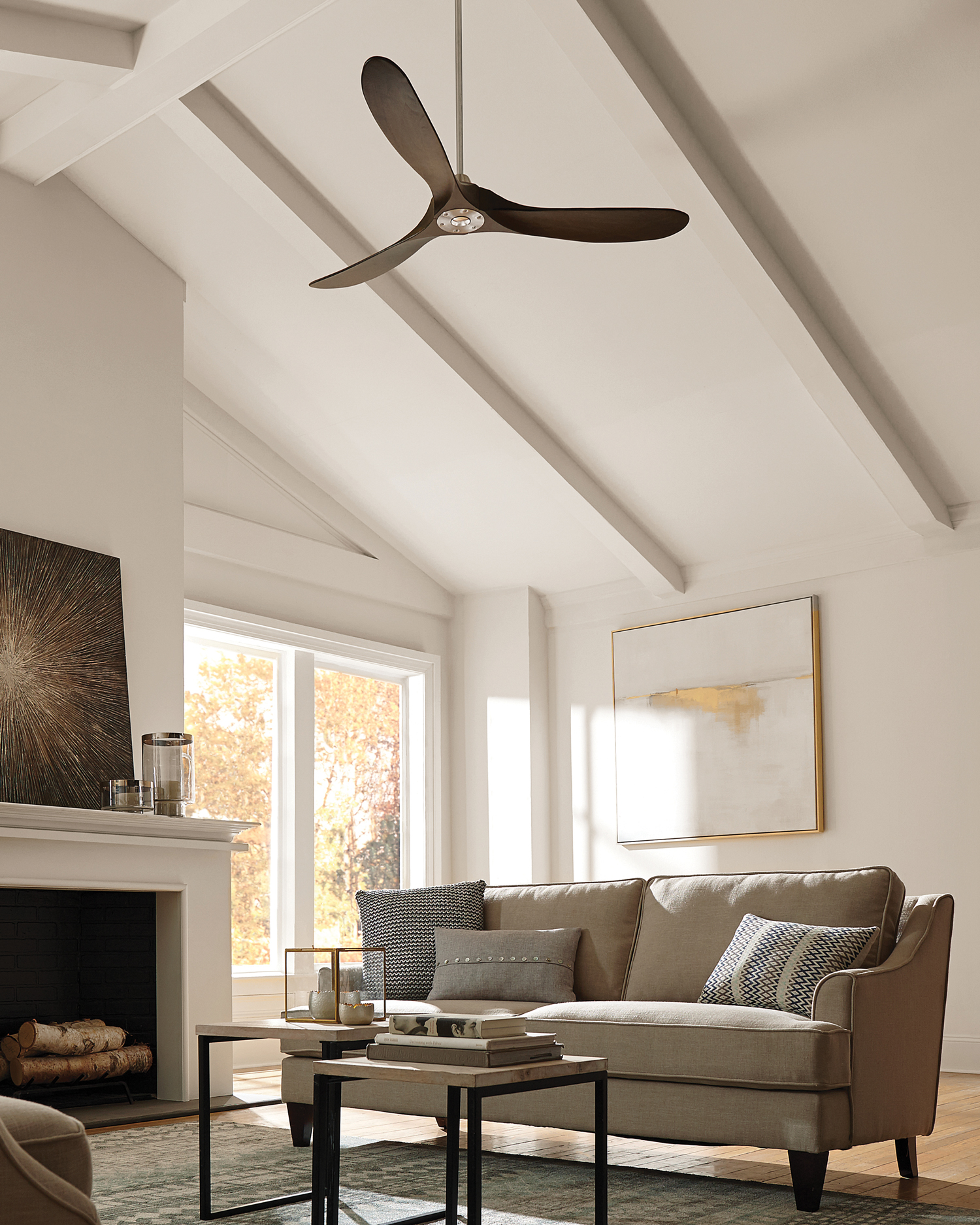
What is CFM and ceiling fan airflow?
Airflow quantifies the amount of air a ceiling fan delivers and is measured in CFM which stands for cubic feet per minute. CFM measurements are taken when a fan is on high speed, then that number is divided by the watts used. This means that the higher the CFM, the more efficient the fan, and the more air it moves. 75 CFM/W is the minimum to be considered efficient, according to ENERGY STAR requirements.
The Environmental Protection Agency requires that all ceiling fan manufacturers put the following information on all packaging and promotional materials so that consumers get an exact understanding of the power behind the fan:
Energy Information
at High Speed
| Airflow | Electricity Use | Airflow Efficiency |
| 7,785 Cubic Feet Per Minute | 27 Watts (excludes lights) | 285 Cubic Feet per Minute per Watt |
This information offers a gauge of the ceiling fan’s airflow and efficiency at a glance, making it easy to compare two or more fans of similar sizes. But what CFM is best?
On high speed:
- Good CFM ranges from 4,000 to 5,000
- Better ranges from 5,000 to 6,000
- Best is over 6,000
What is a DC Motor ceiling fan, and what are its benefits?
DC motors are a newer addition to household ceiling fans that generate additional torque while consuming less than 70% of the power of a typical ceiling fan. They do this by transforming electric energy into mechanical energy as they rotate.
DC motor fans have a slightly higher upfront cost than regular ceiling fans since they need a more expensive electronic speed controller. However, their benefits more than outweigh the costs with the following features:
- Virtually silent operation
- Much smaller motors result in smaller, lighter fans
- Efficient energy use prolongs the fan’s life span
- Higher torque resulting in faster startup speeds
- Up to 6 different speeds
In cases where lighting is included, DC fans typically use LEDs, which only add to the fan’s energy efficiency.
What should I consider when picking ceiling fan blades?
The number of ceiling blades is often an important point in deciding what type of ceiling fan to purchase, but this is becoming less of a question of function and more of personal choice with advancements in technology.
It used to be the case that a five- or six-blade ceiling fan would translate into more efficiency as opposed to a three-blade or four-blade fan, but that’s no longer the case. Since the CFM is the measure of a fan’s airflow efficiency, the number of blades is more related to style than function. For example, a four- or five-blade ceiling fan can provide a more conventional look, whereas a fan with two or three blades can offer a more modern style.
How do different blade finishes affect their function?
Choosing the right finish for ceiling fan blades is largely dependent on the room the fan will be installed in and budget. There are four main blade materials, each with its own distinction:
- MDF
With medium-density fiberboard (MDF) blades, sawdust and other wood remnants are compressed together with a hardening material (e.g. glue or resin). Then, a laminate is overlaid to protect and finish the look. This type of blade is generally used for inexpensive fans. MDF does not hold up well outside; direct contact with water or even the absorption of moisture from the air will cause the blades to swell and droop over time. In dry indoor locations, however, these kinds of blades work fine.
- Plastic
ABS plastic is used in many fan designs, mainly because it is easy and inexpensive to manufacture. Plastic can be molded into almost any shape and can be finished in myriad colors or even to look like real wood. ABS blades also hold up well outside. (Note on reversible finishes: Blades that offer a different finish on each side are typically laminated, but ABS blades can also be made with two different finishes. So, while reversible blades are often made out of laminated MDF, it may not always be the case.)
- Wood
Wood is best for indoor applications, but it can also work for outdoor damp locations. Sourcing and processing natural wood into fan blades takes much more effort and expense than other materials; generally, real wood blades indicate a premium fan. Most wood blades are balsa wood—which is solid, lightweight and aerodynamic—although other types of wood may be used. Real wood blades tend to have a carved look, with a thicker profile than standard flat blades.
- Metal
Metal is best for large spaces where the fan is high above the floor. By code, they must be hung at 10 feet or higher. Metal fan blades are also good for outdoor damp and wet applications; however, the salty air in coastal climates rusts metal quickly so be sure to choose a marine-grade option near the ocean. Metal is also a popular blade choice with small oscillating ceiling, wall and portable fans. For safety purposes, these are usually equipped with a protective cage.
If we haven’t answered all of your ceiling fan questions here, our team of ALA-certified design and product experts is ready to assist you via live chat or at (877) 445-4486.








